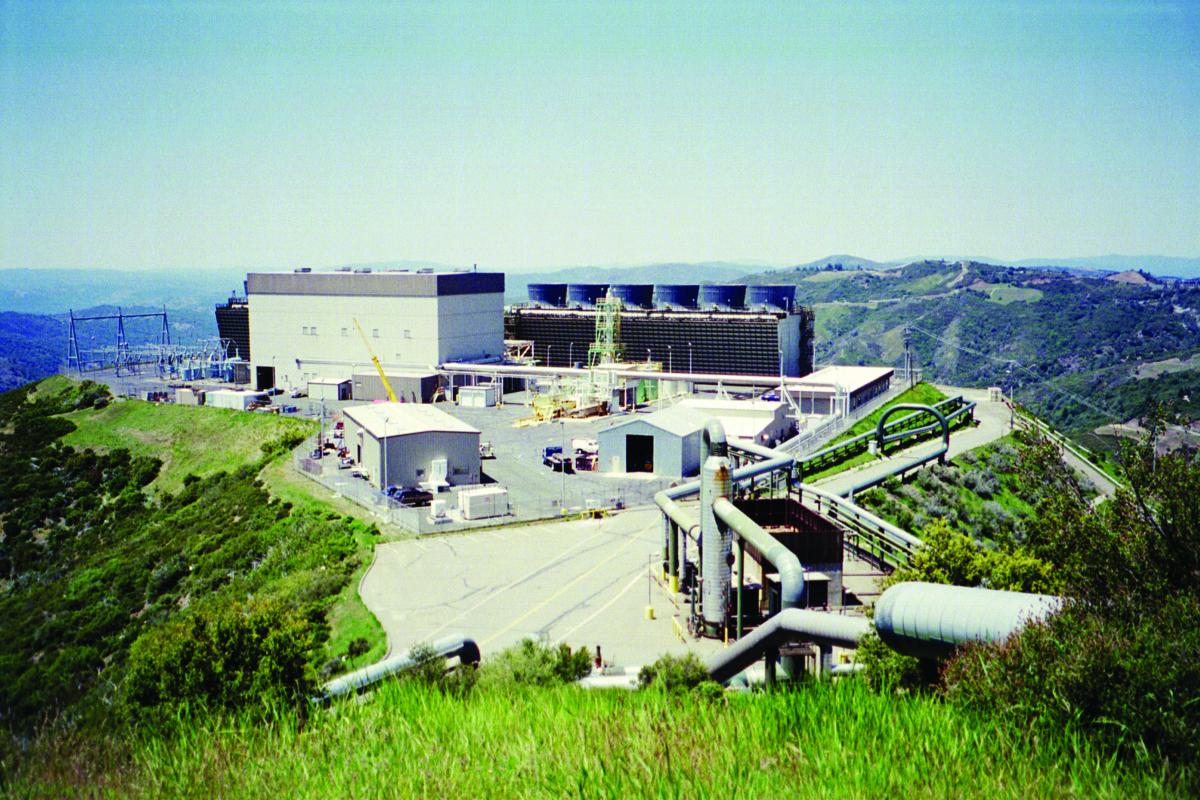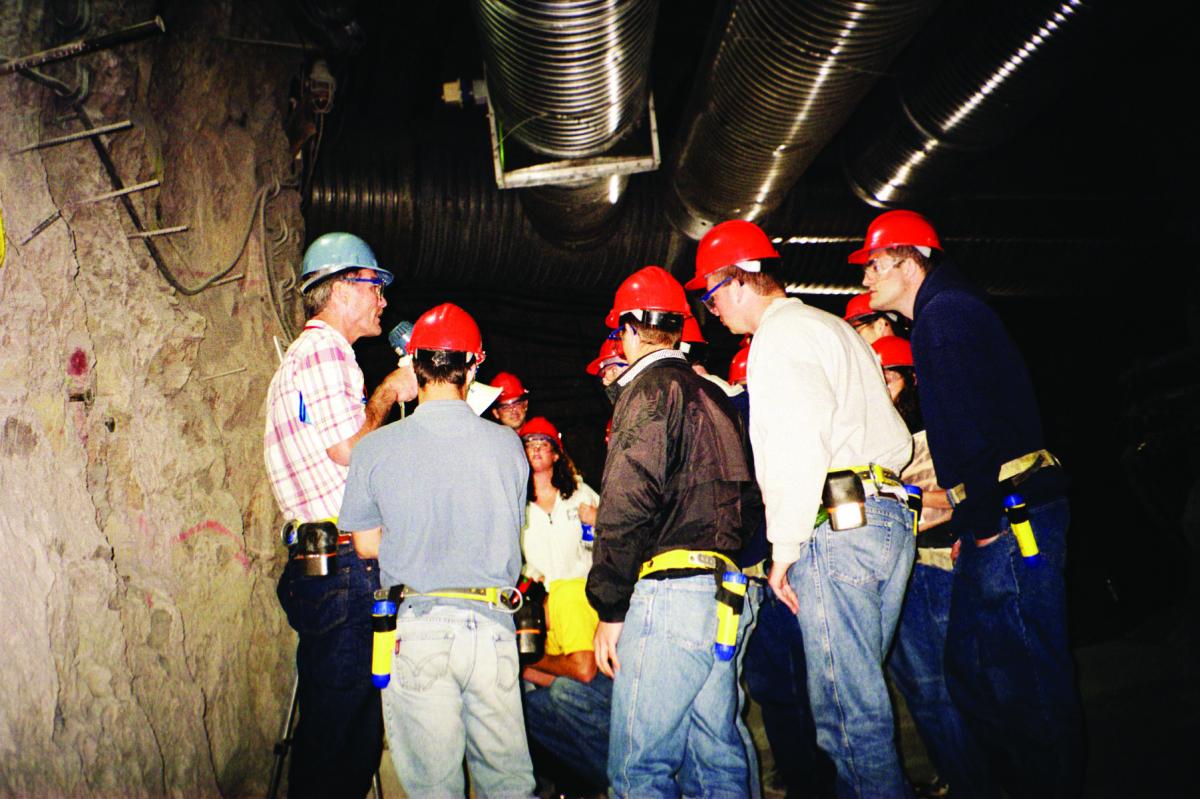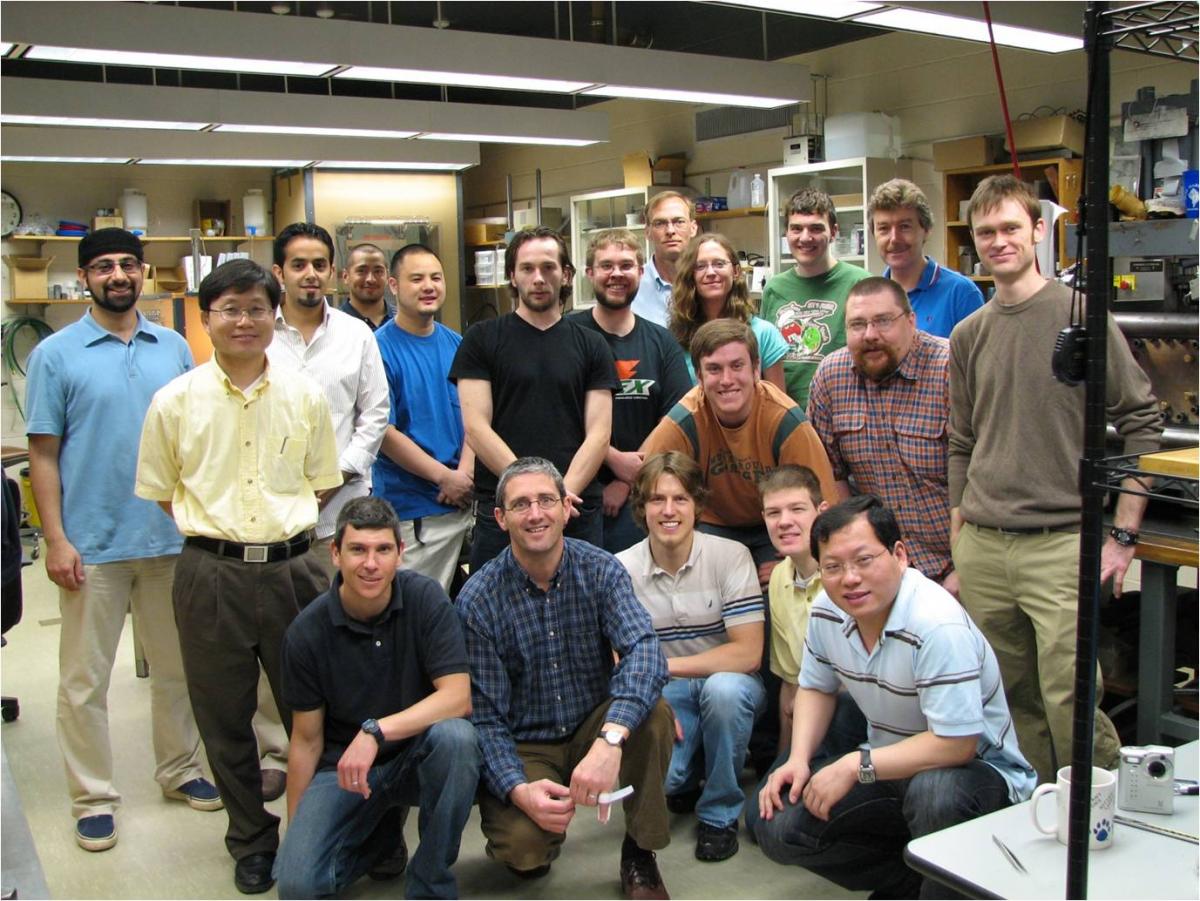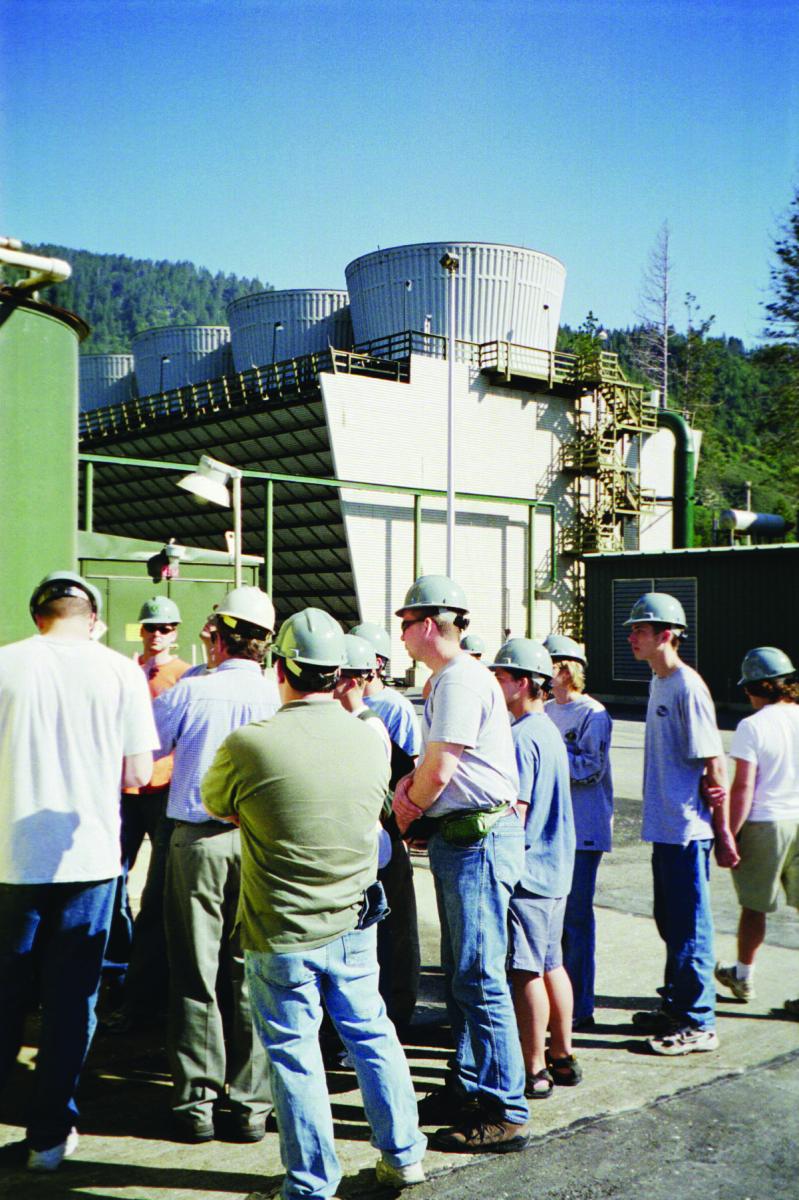Energy Institute researcher looks below the Earth’s surface to uncover answers to some of today’s most important energy issues
By Shea Winton

A hilltop power plant gathering geothermal fluids from the surrounding well field at the Geysers geothermal plant. The Geysers is the single-largest geothermal operation in the world with a capacity of 700MW, located about 100 miles north of San Francisco.
Twenty-five years may seem like a lifetime, but the time flies by, as they say, when you’re doing something you love. For Derek Elsworth, professor, Department of Energy and Mineral Engineering, that includes research and discovering how things work, whether engineered or natural. He enjoys this scientific process and has spent the last 25 years at Penn State conducting research and teaching in the areas of computational mechanics, rock mechanics, and in the mechanical and transport characteristics of fractured rocks.
Rock and fluid physics is an exciting area that has far-reaching applications, from the recovery of hydrocarbon and geothermal resources, and the deep geological storage of CO2 and radioactive waste, to the dynamics of volcanoes and earthquakes.
“It’s an important contemporary area that underpins recovery of renewable energy from the subsurface,” Elsworth said. For example, studying the interactions between rocks and fluids can lead to new technologies to access low-carbon fuels such natural gas from unconventional reservoirs and can expand the U.S.’s alternative energy portfolio by solving problems related to geothermal energy and nuclear power.
CAUSE students at the Geysers with Calpine’s Tom Box.
Understanding Earth’s systems
In 1998, one year after the establishment of the EMS Energy Institute, Elsworth began coordinating all his research projects through the Institute. Since that time, he had led a variety of projects that bridge the fields of earth science and engineering.
His primary research interest has focused on the evolution of permeability (a rock’s ability to transmit fluids) related to reservoirs within natural systems in order to understand how mechanical and chemical changes will cause these reservoirs to grow and diminish over time. By studying various materials and how permeability is changed, researchers can begin to develop mechanisms such as hydrofracing to gain access to natural gas, geothermal reservoirs, petroleum hydrocarbons, or other liquids trapped in rock. Conversely, low permeability is needed in non-penetrable barriers for the safe storage of energy byproducts such as radioactive waste and CO2.
“The big stumbling block in nuclear power is what you do with the waste,” Elsworth said. “Since the 1950s the preferred mechanism to deal with the spent nuclear fuel has been deep geological disposal – so you burry it.” With this solution metal canisters are secured in specialized tunnels backfilled with materials such as low permeability clays and surrounded by the natural geological media. These redundant barriers are needed to entomb the waste for as long as possible, even if a canister ruptures. Therefore, researchers need to understand how permeability evolves over time.
A new geothermal project, hinges on the concept of permeability. is project looks at Enhanced Geothermal Systems (EGS), which, according to Elsworth, is the “holy grail” of geothermal energy.
“The idea is that you can recover thermal energy from the Earth’s crust from anywhere in the world, not just on geological plate boundaries where most of the hydrothermal systems exist,” he said. Hydrothermal systems, where water is present in porous rock, are the traditional geothermal source. The problem is that these systems only exist naturally in very specific places. In the United States, they can only be found on the West Coast and in Alaska. Currently, Elsworth and his team are using the geysers in California and the Newberry Volcano in Oregon as field sites for the research.
The basic principle of EGS is to drill a deep borehole down to about five kilometers and then stimulate the reservoir through hydrofracing or by injecting fluid under high pressure to fracture the rock enhancing its permeability. is allows the fluid to travel through the hot rock.

Bill Boyle, Director of DOE’s Regulatory Authority Office, Office of Civilian Radioactive Waste Management talks to students underground at one of the many in situ experiments at the Yucca Mountain Exploratory Studies Facility, NV – the ESF is a tunnel penetrating 5 miles into Yucca Mountain.
“Once it’s stimulated, you’d want to intercept that hydrofrac, or stimulated zone, with another borehole and then link it up so you can just circulate fl uid in a closed circuit,” Elsworth said. Cold water is pumped down into the rock and hot water is forced up the second borehole to be converted into electrical energy. As a follow-up to a previous project, Elsworth’s research team, with funding from the U.S. Department of Energy, is now executing experiments and developing models to understand the short-term evolution and long-term behavior of these geothermal reservoirs.
A second new project explores permeability in relation to coal beds. Currently methane can be extracted from coal seams by drilling a well into the coal and pumping water from the well. is dewatering releases pressure and allows the methane to flow to the surface. However, once the methane is partially depleted, more can be recovered by injecting the coal seam with CO2. Elsworth and several other researchers are studying and modeling processes related to this enhanced coal bed methane recovery. In particular, the group will look at how permeability changes as the coal swells when injected with CO2 and shrinks when releasing methane.
Going Even DeeperDerek Elsworth is involved with a new large-scale project, DUSEL, to develop a Deep Underground Science and Engineering Lab in the U.S. While several other countries have deep underground research laboratories, nothing below one kilometer exists in the U.S. A study began in 2002 to determine the feasibility of a really deep – 2,200 meters deep – scientific research space within our borders. The Homestake mine in Lead, SD, which is an old gold mine, has been chosen as the site for this facility. Elsworth has an integral role in planning the facilities design. He serves on the science steering committee charged with interfacing the scientific community with the facility. Basically, he is helping to ensure the site design fits the needs for the proposed experiments. The project was initially motivated by the desire to have a physics lab where scientists can begin to understand dark matter and dark energy in the universe away from the “noise” of cosmic rays. Researchers plan to build detectors, or large underwater caverns, 1,500 meters underground to observe the interactions of sub-atomic particles. The DUSEL project will also provide important research opportunities for the fields of Earth science and engineering and Elsworth anticipates being involved with many projects. One experiment will emulate geothermal reservoirs to look at the thermal response of rocks to heating. In another project, researchers will examine water circulation in the Earth’s crust and several other projects are aimed at increasing the ability to predict earthquakes and other natural disasters by inducing faulting in rocks to understand the behavior and the strength of rocks. Currently the preliminary design and rehabilitation of the existing mine into the initial parts of a laboratory is taking place. The National Science Foundation (NSF) is providing the primary support for this project with some additional funding from the U.S. Department of Energy. While DUSEL really got started in 2004, it hasn’t been completely ratifi ed by NSF yet. The project is moving through the necessary channels and will go to the National Science Board for approval in May 2011. It will then be presented to Congress and, if approved, construction is slated to begin in 2012 with experimentation starting in 2015. |
Identifying these changes will help in understanding the challenges related to this technique, which in addition to improving methane recovery, could become a key technology for CO2 capture and storage. CO2 storage is one possible solution to reduce the effects of greenhouse gas byproducts from fossil fuels and it’s another area in which Elsworth is actively conducting research. Just this past year, in September 2009, he ran a roundtable forum on CO2 sequestration sponsored by the Institute of Advanced Studies at the University of Western Australia. The forum engaged members from industry, academia, and government in discussions about the critical issues with CO2 sequestration. Most of the talk focused on the Gorgon project, which is a natural gas recovery project off the northwest coast of Australia – a joint venture between Chevron, Exxon Mobil, and Shell. However, the gas extracted from this off shore gas field is close to 14% CO2, higher than normal CO2 levels, so the project is looking into the possibility of reinjecting the CO2 under the nearby Barrow Island Nature Reserve.
The forum resulted in a detailed summary of the scientific issues with CO2 storage with the expectation that the interested parties will ultimately fund some of the work to address these concerns. Major issues outlined in the report relate to characterizing reservoirs to predict long-term security of the CO2, understanding process interactions that will result as a reservoir system is stressed, and monitoring a reservoir system’s behavior and verifying that behavior against predicted responses. By addressing these three needs scientists will be able to identify the best CO2 storage locations and predict any changes that may occur due to changes in temperature, pressure, or other stressors. The overall goal is to have the lowest possible permeability in the rock and to make sure the CO2 stays put for a long period of time.
Falling into the right place
“You kind of stumble into these things,” Elsworth said of how he got into the field of rock and fluid physics. He stumbled into it while working on his Ph.D. in the early 1980s. He began looking at the response of dams on rivers to revised flood sizes, which meant he was studying the interaction between rock and fluids – something he had never worked on before.
At that time, probable maximum flood magnitudes (PMFs) were being revised upwards and many of the dams built in the 1940s were up for relicensing, then 40 years later. Under these lager design floods many of the dams would be overtopped. One of the issues related to a dam’s stability is its mechanical response to being overtopped.

Students and faculty from the G3 Center. Derek Elsworth is first from right in back row.
“So to pay my way through graduate school, I basically did consulting on that to look at the role of fluids flowing underneath dams, evaluate uplift pressures that would be generated, and how they would affect stability,” Elsworth said. “I remember saying at the time that I didn’t think this would be a path I would choose to go on.” Instead he continued to work in this area for the rest of his professional life.
One of the highlights throughout Elsworth’s career has been the ability to work with graduate students.
“Working with graduate students is a huge privilege I think,” he said. “ They are the engines that allows us to do the things that we do.”
He enjoys watching their personalities develop over a period of time and seeing their professionalism come out when they are working in non-typical roles, such as when they are traveling or working in the field.
“From the time when you’re teaching them stuff to the time when they are teaching you stuff. I think that’s a curious and amazing transformation.”


